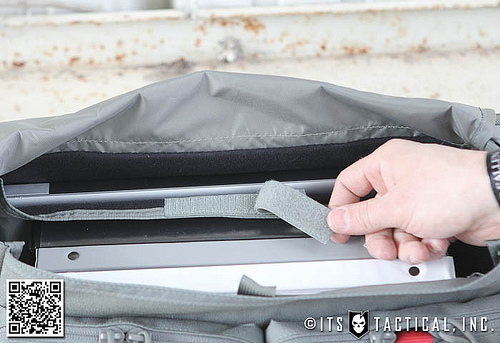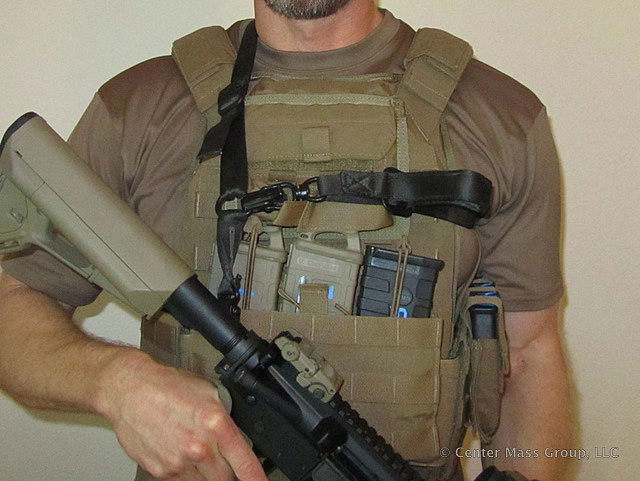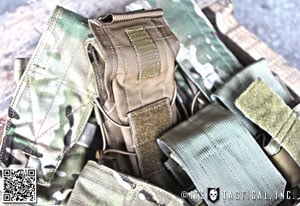Cubes and Ounces: Blue Force Gear Project Helium Whisper
Cubes and Ounces: Blue Force Gear Project Helium Whisper
Anyone with true operational experience knows the mantra “Cubes and Ounces.” The slickest tactical doo-hickey is all good until you have to hump it ten clicks over uneven terrain. When you’re required to carry the entirety of your worldly possessions on your person, every cubic inch and especially every ounce becomes a major consideration.
As a Team Medic, this was an especially big deal to me because I had to carry my med gear in addition to all of my tactical equipment. We used to joke about the new guys fresh from selection and training because of the amount of gear they would strap to themselves. On the civilian side, we used to call them “SWAT Turtles” because our thinking was that if they fell on their back they probably wouldn’t be able to get up unassisted. On the flip side, the senior guys were the ones who streamlined their gear to the max. Field stripped MRE’s anyone?
Project Helium Whisper
I was excited when I heard from Ashley Burnsed, President of Blue Force Gear (BFG), that he had something in the works he knew I would like. I made the acquaintance with Ashley several years ago when I began using his slings operationally and in 3 gun competitions. He later came out with his line of Ten Speed Pouches, which were a lightweight and flap free alternative to traditional pouches and I immediately became a big fan.
Not only because of the lighter weight but because the use of elasticized material does away with the need for retaining flaps. I am a huge believer in gross motor skills under combat pressure. I have seen way too many people struggle to perform intricate motor skills under time/threat conditions. ITS did an excellent overview of this subject some time back basically arguing the opposite, “I can pull a trigger under stress and that’s a fine motor skill” while I agree in principle, my feeling is that I want to eliminate as many variables as possible to increase my survivability. In other words, if I don’t NEED a flap over my magazines then why have one?
Two nice additional benefits of the pouch designs are that they can securely retain similarly sized but differently shaped objects (i.e. tourniquet instead of an M-4 magazine) and that when empty, they pull back flat out of the way.
The Magic’s in the Material
[flickr id=”6299121715″ thumbnail=”medium_640″ overlay=”false” size=”medium” group=”” align=”center”] A week ago I received an 8.5” X 11” envelope in my mailbox from BFG. Another catalog I assumed. I welcomed the new edition as they always put out a nice publication and the latest has an outtake photo on page 13 that always makes me laugh. No spoiler, you will need to download or order up a copy for that one. Anyway, I was correct in that there was a catalog inside with a sticker, shipping invoice and a plastic bag?
Inside the bag I found not one, not two, but four of the newly announced Project Helium Whisper pouches! Unreal. Contained in a single bag inside a standard envelope they had managed to fit a Triple M4 Magazine Pouch, a Single M4 Magazine Pouch, a SSE Pouch (a site exploitation bag) and their Project Helium Whisper version of the Trauma Kit Now Medical Pouch. Now that’s what I call Cubes and Ounces conservation. I was intrigued.
The magic to the Helium Whisper pouches lies not only in the use of Ten-Speed style elastic material for the pouch bodies but in the new style of back plate. As explained on the BFG website, the traditional MOLLE (Lean back from the keyboard and keep reading — we can debate the use of MOLLE vs PALS terminology later — we all know what I am talking about here) mounting system has been replaced.
“The secret to Blue Force Gear’s patent pending technology is our one-piece back panels. The material used to form our new MOLLE attachment system is a highly durable laminate that has been cut to our exacting tolerances. CAD programming and CNC laser cutting ensures tolerances to within a thousandth of an inch.”
Having some experience in the nylon design and sewing industry since leaving government service, I’m intrigued by the concept of laser cutting of materials as tolerances can be an issue. I can’t tell you the number of times I have had to struggle with a MOLLE pouch strap that was just a gnat’s hair too short to snap down securely. I also have a plate carrier from a very reputable maker that has an entire column of attachment webbing that is out of spec.
The flexibility inherent in the Helium Whisper strap material allows it to be bunched down to fit through an undersized channel. Something not possible with traditional stiffened nylon straps. On initial examination, I immediately began to worry about the strength of these straps as they are very thin. BFG touts the material as a “highly durable laminate” and my testing turns out to support their assertion.
First thing I did was simply grab a strap and pull as hard as I could figuring it would stretch or even possibly break. I was wrong. The strap didn’t stretch at all and I have since seen a photo on-line of a couple of guys playing tug of war with one of these pouches. Although I’m sure I could come up with a way to break one of these, the point is that the material is plenty strong for its intended use of retaining a loaded magazine or other appropriate items. In a more practical test, I mounted one of the pouches and carried around my fully loaded plate carrier by the pouch itself without it failing. That’s good enough for me.
Ten-Speed Triple M4 Mag Pouch
[flickr id=”6299121685″ thumbnail=”small” overlay=”false” size=”medium” group=”” align=”right”] On a secondary note, I had concerns regarding the durability of the outer pouch material when I first obtained a Ten Speed pouch a couple of years ago. Despite some pretty hard use, I haven’t run into any issues. I would attribute this primarily to the fact that the elastic material makes the pouches so low profile that they aren’t getting snagged very often. But no one should argue that the elastic material is going to have the abrasion resistance of 1000D Cordura.
If your mission has you doing running belly flops onto cement day in and day out then you either need to be prepared to replace your equipment on a shortened life cycle plan, or purchase the heaviest/thickest built pouches you can find. In my mind, the light weight and low profile of these magazine pouches is a logical trade off for any potential life cycle issues. So the mag pouches are small and light weight, they fit on my kit even when my attachments are out of spec, they don’t employ flaps or bungee retaining straps and I can even put non-traditional items such as medical gear in them. Fantastic, but what about the SSE pouch and Trauma Kit Now?
Ten-Speed SSE Pouch
[flickr id=”6299654984″ thumbnail=”small” overlay=”false” size=”medium” group=”” align=”right”] Sensitive Site Exploitation Pouch/Dump Pouch or whatever you want to call these bags, I will say that this is an item I make room for on my kit. The ready ability to have a pouch to store loose items contained in a 3” wide X 4” high space is worth the price of admission. To deploy the bag, you simply pull straight down on the tab hanging out the bottom of the pouch. You can easily adjust the length of the tab by tucking the excess back up into the pouch thus alleviating any worries of a premature deployment.
Once deployed, the bag itself measures approximately 9” wide X 10” deep when placed flat on a surface. Any math genius amongst our readers can feel free to work up the Cubes this bag will hold. I will just say that I can easily drop a Sig P226 or a handful of M4 mags inside with room to spare. A nice added touch is the drawstring with Cordloc at the top.
Trauma Kit Now!
[flickr id=”6299654884″ thumbnail=”small” overlay=”false” size=”medium” group=”” align=”right”] Last, but not least, is the Helium Whisper version of BFG’s Trauma Kit Now! medical pouch. As a medic, I have been a fan of this pouch for some time primarily because of the method in which it presents the medical items when deployed. Going back to the earlier gross motor skills/performance under stress conversation, my experience has been that in addition to becoming “all thumbs” under pressure, people also experience a marked narrowing of visual acuity (tunnel vision) and a reduction in cognitive reasoning (AKA “I get dumb when people shoot at me”).
The Trauma Kit Now utilizes a two part design that has an inner panel that holds each medical item under a separate retaining strap. When the deployment handle is pulled upwards, the inner panel comes out of the outer pouch and opens like a book, clearly displaying the contents. The unfolded panel can be laid on the ground to work from or even handed to another team member when required. The front flap of the pouch has a loop Velcro field so you can add a cross or MED patch if desired. The top of the pouch flap has three webbing straps so you can carry a hook knife/shears/or other item tucked underneath. It should be noted that the exterior of this pouch, unlike the magazine pouches and SSE pouch, is constructed from 500D Cordura.
Weight Reduction
Unique features aside, the original promise of this product line was a reduction in weight. So I utilized a calibrated postal scale to weigh each of the pouches in order to compare them to more traditionally designed pouches. The results did indeed show a substantial weight savings. While the weight savings is measured in ounces, as I said in the opening paragraph Cubes and Ounces matter.
A traditional Triple M4 magazine pouch (open top, bungee retainers) came in at 8.0 ounces, a Double M4 magazine pouch (w/flaps) came in at 6.4 ounces. The Helium Whisper Triple M4 magazine pouch came in at 2.8 ounces which was less than half the weight of a traditional pouch with less capacity. The Helium Whisper Single M4 magazine pouch at a featherweight 1.1 ounces resulted in an even greater margin with a traditional single open top pouch weighing 2.8 ounces and a flapped single pouch weighing 3.9 ounces.
The SSE pouch weighed in at a mere 1.8 ounces confirming my initial assessment that its utility more than compensates for its weight and size. Finally, I weighed the Trauma Kit Now medical pouch against a similarly sized IFAK pouch. I was interested in this comparison in that the BFG trauma kit pouch is made of traditional materials with the Helium Whisper back plate being the primary difference between this pouch and the traditionally designed IFAK. The scale revealed that there was again substantial weight savings from the Helium Whisper design with the Trauma Kit Now coming in at 7.1 ounces versus the 10.7 ounces of the traditional IFAK.
Given the substantial weight savings seen in this small selection of pouches, I can envision the weight savings getting into the pounds if BFG decides to expand their product offerings in the Helium Whisper line to incorporate other fits such as radio holders, grenade pouches, hydration carriers, etc. I will keep a close eye on this product line as it develops and report back accordingly. Until then, stay safe and if you decide to reach out to Blue Force Gear let them know that ITS Tactical sent you.
Editor-in-Chief’s Note: Please join us in welcoming J.B. Gleason as a contributor to ITS Tactical. We have known him for quite a while personally and professionally and welcome his input. J.B. is now retired from government service and has considerable experience in tactical medicine and tactical operations. Look for more articles from him in the future, especially in reference to his passion for introducing basic trauma care to line Law Enforcement Officers.
[flickrset id=”72157627896607427″ thumbnail=”thumbnail” photos=”” overlay=”true” size=”medium”]











Discussion